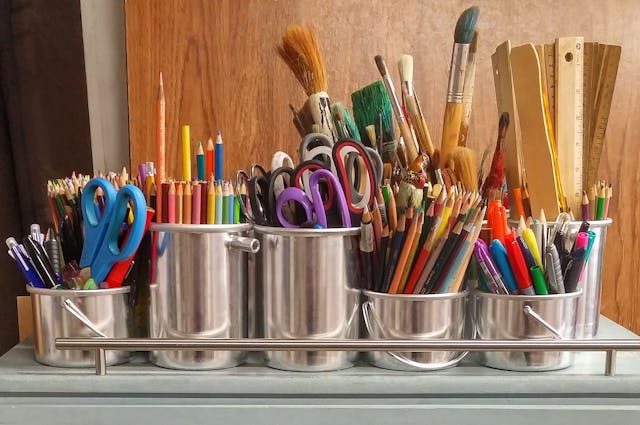We live in a world that’s fast, digital, and often hands-off. After all, emails replace letters, streaming replaces holding a book or record, and convenience rules nearly every decision. But even with all this, there’s still something so deeply satisfying about making something with your own hands, and whether it’s baking bread, sketching, building a shelf, or knitting a scarf, the act of creating has a number of excellent benefits, so keep reading to find out more.
The Process Is The Most Important Part
Crafting isn’t only about the finished item – it’s about the act itself. For example, when you’re painting, you don’t just care about the final canvas, you enjoy the brush in your hand, the colours blending, the mistakes and happy accidents that give you whatever it is you end up with (no matter if it’s ‘good’ or ‘bad’). And the same goes for quilting, card-making, or scrapbooking, and everything else. Basically, the end result really isn’t that important because as long as you enjoy the process and get something out of it, that’s the main thing.
That’s why crafts have such enduring appeal – you don’t have to be perfect (far from it!), and no one ever has to even see the slightly wonky scrapbook page or handmade card if you don’t want them to.
Mental Health Benefits
There’s growing recognition that crafting supports mental health, and that could be to do with the focus that’s needed because it takes you away from overthinking and endless to-do lists. The fact is that repetitive actions like knitting or stamping can be meditative, almost like a form of therapy, and it slows the mind, channels energy, and offers you some kind of control in a world that often doesn’t feel all that controllable.
Studies have actually shown creative activity reduces stress and can help ease anxiety, but even if that wasn’t general knowledge, you don’t really need science to tell you what you already feel after you’ve spent time enjoying your crafting.
Building Patience And Resilience
Crafting doesn’t always go to plan – a stitch gets dropped, a piece of wood splits, or the colours don’t look quite the way you imagined, and so on, and these moments can be frustrating, but they’re also a chance to build patience, and that can be really useful.
Unlike many parts of modern life that promise instant results, crafting takes time – you can’t rush a hand-made quilt or a model ship. So the entire process teaches resilience and the value of persistence, and when you finally do finish, the sense of pride is so much more because of the effort that went in.
This patience often comes into other areas of life too, and people who craft regularly sometimes find they’re more willing to stick with challenges at work or handle setbacks at home with a little more calm and patience.
A Boost For Creativity
You don’t have to think of yourself as artistic to enjoy crafting because creativity isn’t about producing a masterpiece, it’s about exploring ideas and solving problems in new ways.
When you’re crafting, you’re constantly making decisions, like which fabric to choose, how to arrange beads, whether to mix one paint colour with another, what to buy from CraftDirect.com… These small creative choices add up, and they keep your imagination active, and over time, crafting can even make you more confident in trying out your own ideas.
This kind of everyday creativity is really valuable in your life because it can help you see new solutions in your job, tackle problems at home in inventive ways, and generally stay more open-minded.
Physical Benefits
It might not feel like a workout, but crafting can also bring physical benefits, as strange as that might seem. For example, fine motor skills improve as you work with small, detailed movements, whether that’s threading a needle or modelling clay, and that can be especially helpful for children, who develop hand-eye coordination through activities like cutting, folding, or gluing.
For adults, especially older ones, these kinds of tasks keep the hands and fingers nimble, and there’s some evidence that crafts like knitting can help maintain dexterity and even ease symptoms of arthritis through gentle, regular movement.
Depending on the craft, there can also be larger physical elements as well. Furniture building, for example, requires strength, balance, and practical skill, and gardening, which is often considered a type of craft, combines creativity with physical activity and time outdoors, offering a whole extra layer of health benefits.
Saving Money And Reducing Waste
Crafting can be good for the wallet too because instead of buying mass-produced goods, you can often make things yourself for less money, and that can include home décor, clothing alterations, handmade gifts, or even upcycled furniture, and it can all be done on a budget.
There’s also the eco-friendly side of crafting – many people use materials that would otherwise go to waste, like repurposing jars into storage containers or turning fabric scraps into quilts, and when sustainability is more important than ever, crafting means you can play a small but important part in reducing waste.
A Productive Way To Unwind
Finally, crafting offers a way to relax that feels more productive than just switching on the TV – you still get that sense of winding down, but you also end up with something tangible at the end.
In other words, it’s a way of spending leisure time that leaves a positive mark – instead of hours disappearing without much to show for it, you can point to a finished project and feel proud, and that little sense of progress can do wonders for self-esteem and general happiness.
Final Thoughts
Crafting isn’t about perfection, and it doesn’t need to be complicated, and from improving mental health and building resilience to saving money and helping the environment, the benefits of crafting are long-lasting and important.
You don’t need to invest in expensive tools or supplies to get started either – a ball of yarn, some paper and glue, or even old items waiting to be repurposed are enough to begin. So why not get started?

